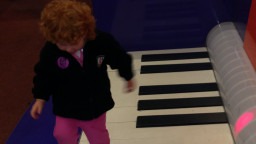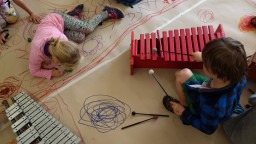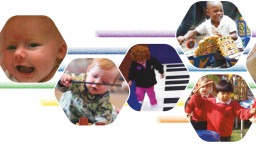Vocalising and Singing
It goes without saying that singing in early childhood is commonplace and we have a range of types of songs that we draw upon; peepo songs, movement songs, action songs, lullabies and lap songs to name a few.
It is, without doubt, an important tradition in early childhood and one which can take place anywhere at any point as the only instrument needed is the human body. Nursery rhymes and traditional songs are often incorporated into the day to day life of early childhood settings. There is however a focus on children reproducing songs (e.g. sing well known songs) and much less attention is given to children’s individual vocalisations and creative singing.
Vocalising begins at birth as stated in Musical Development Matters:
The “sing song” type of conversation mentioned above is also known as ‘Infant-directed speech.’
The prosodic modifications of infant-directed speech, such as its large pitch contours and rhythmic patterning, make the speech more like music. Infants respond to and attend to these musical qualities, which communicate meaning. (Rock et al. 1999, p.527).
Infant-directed speech is also described as ‘Motherese’, ‘Fatherese’ and when referring to both mothers and fathers the term ‘Parentese’ is drew upon.
Malloch (1999) conducted studies which examined mothers and infants interacting vocally. Computer based technology was used to analyse these interactions for musical qualities. The study found that six and twelve-week-old infants vocalised naturally in a co-ordinated and rhythmic fashion with their mothers. It appeared that mother and infant explored pitch-space in a methodical manner over both short and long intervals of time.
From this work, the theory of ‘communicative musicality’ was born and found precise formulation in terms of three parameters: pulse, quality and narrative:
- ‘Pulse’ is the regular succession of discrete behavioural events through time, vocal or gestural
- ‘Quality’ refers to the modulated contours of expression moving through time.
- Pulse and quality combine to form ‘narratives’ of expression and intention.
(Malloch & Trevarthen, 2009)
‘The term communicative musicality is not to imply so much that mother/infant communication is musical, rather that what we generally call music is one drawing-together of the elements of pulse, quality and narrative- elements that are intrinsic to all human communication’. (Malloch, 1999, p.47).
You can watch a short talk given by Professor Colwyn Trevarthen speaking about the Musicality of Language here:
Singing with young children
When we plan to sing with children we need to carefully consider what the purpose is.
There can be many purposes, for example:
- Songs to develop singing skills
- Songs for children to listen to
- Songs to move to
- Songs for relaxation
- Songs to share stories
- Songs to explore elements of music, e.g. dynamics (loud/quiet), tempo (fast/slow)
As with other areas of learning we need to understand unique children and offer them experiences that support their individual development. Throughout the ‘Vocalising and Singing’ aspect of Musical Development Matters you will see statements such as:
- Merges elements of familiar songs with improvised singing.
- Has strong preferences for songs he or she likes to sing and/or listen to.
- Pitch matches i.e. reproduce with his or her voice the pitch of a tone sung by another.
The above statements offer examples of children’s singing development and interests.
To support children’s singing development, one has to be very selective about the songs to teach young children and the range of pitch that is offered. As stated in Musical Development Matters:
- When supporting children to develop their singing voice use a limited pitch range, eg “Rain rain” uses a small pitch (high/low) range compared to “Hot Cross Buns”.
This does not mean that one should not sing ‘Hot Cross Buns’ as this may be a fruitful listening activity, if however, one is hoping to support children’s singing development then a smaller pitch range would be more suitable as indicated above.
It is also important that adults singing spontaneously and foster an enjoyment for singing by making up songs and exploring vocal play.
Children who choose not to sing within group singing times may be actively observing. You will often hear children singing the songs that they didn’t sing in group times, within their play outside of the group time:
Flohr, (2005) offers a detailed exploration of singing development and the development of the larynx. This offers physiological detail about children and their developing voices. In ‘A Guide to Singing with Young Children’ (2018), Greenhalgh offers practical suggestions and tips to support singing in the early years. Huhtined-Hilden & Pitt, (2018) offer ‘Perspectives on the development of singing’; ‘The socio-cultural aspects of singing’ as well as practical suggestions for teaching songs.
Singing in early childhood is perhaps more complex than is often considered.
Observing children’s vocalising offers many areas to consider and reflect upon. Children often sing within their play e.g. sing to and with props and also whilst they play e.g. hum whilst playing with clay, water. Children’s singing abilities should not therefore be assessed solely within group, or adult led singing times.
Young (2009, pp.82-87), lists a range of types of vocalisations:
- Musical drama – singing within role play
- Playing with known songs
- Free melody
- Chant
- Movement singing
- Singing for toys
- Song making in group activity
Moorhead & Pond (1941) observed children aged 2-6 years old engaged in chanting, singing, and playing instruments in a naturalistic environment.
They found that there were 2 forms of singing – chant and song:
- Chant = rhythmically driven, often groups,
- Songs = wandering flexible rhythm and more individual. Vocalising inseparable from other play.
Moog (1976) studied children’s musical experiences and went into the homes of 500 children, aged 6 months to 5.5 years old. Moog catalogued three types of spontaneous song in this age group, which he labelled as:
- Imaginative - improvised using original material and snatches of known songs.
- Pot-pourri song - created by piecing together parts of songs the children knew but did not contain original material.
- Narrative song - sung monologue, was song that sounded like a sung narrative, but which rarely carried any understandable meaning.
The above examples offered by Young, Moog, and Moorhead & Pond can offer us frameworks to enable us to observe children’ singing carefully.
Observe the group music making in the following clip:
What can we see and hear happening in this clip?
Here are some suggestions:
- Rhythmically driven chant like vocalising
- Adult valuing and joining in the children’s music making, sensitively
- Instrumental play and vocal play are intrinsically linked
- Playing with words within the music making
- The sound connects the group
Points to consider
Is this a group or is this music initiated and led by one child with 2 others (the adult and other child) joining in?
Observe the following clip:
What can we see and hear happening in this clip?
Here are some suggestions:
- Children playing with a familiar tune
- Singing whilst drawing
- Drawing the rhythm of the melody (intermittently)
- Children singing together
Points to consider
Some children are provoked to move with sounds, this can be sounds they are creating themselves or sounds they are listening to. This is very apparent here as the girl moves her felt tip on her paper whilst she sings and incorporates the mark making into the music making. This demonstrates how the movement is intrinsically related to the music making. This is an example of multimodality which you can read about within the Moving and Dancing section.
Observe the child in the following clip:
What can we see and hear happening in this clip?
Here are some suggestions:
- Narrative song
- Repeated phrase
- Singing whilst moving
- Singing within play
- Meaningful, emotional content
Observe the baby in the following clip:
What can we see and hear happening in this clip?
Here are some suggestions:
- Sound communication between adult and baby
- Vocal play – both adult and baby
- Time for the baby to respond
Observe the child in the following clip:
What can we see and hear happening in this clip?
Here are some suggestions:
- Narrative and imaginative song
- External aspects influence the content – snow
- Clear structure – beginning and end
Points to consider
Children may be more comfortable to play vocally within their home environment. Explore strategies to encourage parents/carers to share their children’s music making from home
Observe the child in the following clip:
What can we see and hear happening in this clip?
Here are some suggestions:
- Enjoyment
- Supportive adults who value the child’s music making
- Imaginative - improvised using original material and snatches of known songs
- Understanding of structure – start and end
You can access the other 3 aspects of Musical Development Matters by clicking below:
References
Flohr, J.W. 2005. The Musical Lives of Young Children. New Jersey: Pearson Prentice Hall
Greenhalgh, Z. (2018). Music and Singing in the Early Years, A Guide to Singing with Young Children. Abingdon Oxon: Routledge.
Huhtinen-Hildén, L. and Pitt, J. (2018). Taking a Learner-Centred Approach to Music Education, Pedagogical Pathways. Abingdon Oxon: Routledge.
Malloch, S., & Trevarthen, C. (2009). (Eds.). Communicative musicality: Exploring the basis of human companionship. Oxford: Oxford University Press.
Malloch, S. N., (1999). Mothers and infants and communicative musicality. Musicae Scientiae Special Issue, pp. 29-57.
Moog, H., (1976). The Musical Experience of the Pre-school Child. Translated by Claudia Clarke. London: Schott.
Moorhead, G. E., and Pond, D. (1941). Music of young children: Pillsbury Foundation Studies. Santa Barbara, CA: Pillsbury Foundation for Advancement of Music Education
Rock, A. M. L., Trainor, L. J., and Addison, T.L. (1999). Distinctive Messages in Lullabies and Playsongs. Developmental Psychology. 35, (2), pp. 527-534.
Young, S., (2009). Music 3-5 (The Nursery World / Routledge Essential Guides for Early Years Practitioners). Abingdon: Routledge.



